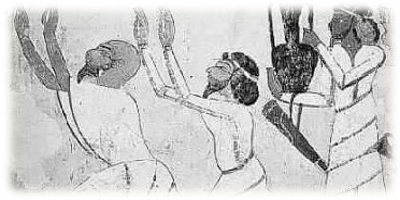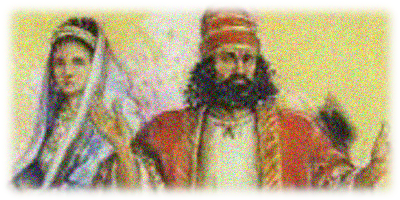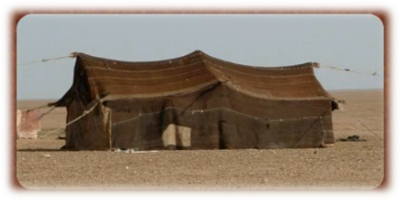The ancient Hebrew people were very colorful in their apparel, especially the priests. God used such clothing to serve as reminders and symbols of His truths and commandments to His people, though delving into such symbolism in depth is beyond the scope of this article. There are three common, general words for clothing or garments: beged, simlah, and salmah. The last two are thought to be the same word via transposition of the "l" and the "m" and both have a sense of "to clothe". Simlah as used in Genesis 35:2 seems to include not only clothing but anything put on the body, such as earings (vs. 4). Salmah is used in a descriptive passage in Psalms 104:2 which describes God as clothed in light.
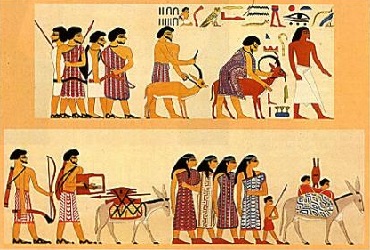
As for things made of cloth or thread the Hebrews commonly wore robes, sashes (belts), and turbans. Most garments were made of linen (especially the priest's garments), and a few of wool. Very few would have been comprised of both wool and linen threads though (Leviticus 19:19). Often only the wealthy could afford the multitude of fineries mentioned in the Bible but almost everyone wore a robe. The most common type of robe mentioned is the kethoneth. This word comes from a word that means "to cover", and describes an outer garment. The word is translated as coat and robe, and it can describe a basic robe or a fine robe. Joseph's coat of many colors was a kethoneth. Also the fine robes of the king's virgin daughters were kethoneth (2 Sam. 13:18). It is used as an evidence of honor of high position in Isaiah 22:21. Such robes were drawn up when working or running (2 Kings 4:29; 1 Kings 18:46). Similarly Peter tells us to "gird up the loins of our mind" (1 Peter 1:13).
Another robe mentioned is addereth, a rather unique type of robe. It can carry the meaning of glory (Zech. 11:3). Is commonly worn by prophets (John the Baptist probably wore a type of rough addereth ) and Esau wore one as well. The NET Bible makes the comment "Addereth is a common cloak that prophets wore, a robe. אדרת (aderet) alone suggests something of beauty and honor [Josh 7:21]. The prophet's attire may have been simple but the image it conveyed was one of great dignity." Finally the last common type of robe was a me'iyl (1 Samuel 18:4) another outer robe. Jonathan gave this type robe to David.
Now transitioning to the next in the list I should note that Johnathan also gave David his girdle or belt. This was quite a gift because this was no normal girdle. The word used in this instance is chagowr. A chagowr commonly describes an expensive girdle, a battle belt (2 Sam. 18:11). It was an honor to receive one and was even used as criteria for eligibility to fight in battle (2 Kings 3:21) implying that it must be earned. And to be given one, as Jonathan did for David as Joab mentioned (in 2 Samuel), would be a great honor. On a lesser scale it is also used of the "apron" that Adam and Eve tied about them to cover their nakedness and it also describes a decorative belt for wealthy women (Isa. 3:24). The word chagowr according to my count only occurs 8 times in the Bible. Ezowr is another type of girdle. It is a common girdle, mentioned frequently in Jeremiah 13. Elijah wears an ezowr. It is also used in Ezekiel 23:15 as worn by Chaldean warriors. The last type of belt commonly mentioned is abnet. It refers to a sash which was reserved almost exclusively for royalty or the priest hood (Ex. 28:4, 39, 40; Isa. 22:21). On the Assyrian artifact dubbed The Black Obelisk of Shalmaneser III, King Jehu of the Bible is pictured as wearing a fine robe and such a sash as was worn by high ranking officials. Another article of clothing of interest on the artifact are the tassels attached to the fringes of Jehu's robe, which God commanded the Israelites to wear for remembrance of His ordinances (Num. 15:38-40).
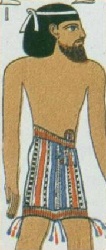
Finally, concerning apparel made of fabric, turbans or caps were worn on the head. Linen headdresses, twisted as turbans were common for men (pe'er, livyah), wealthy women (pe'er), bridegrooms (pe'er), and priests (migba'ah) (Ex. 28:40; Isa. 3:20, 61:10). Pe'er is the most common word used for a turban. It denotes a garland about the head, yet by extension means any covering, and is also used in the sense of adornment. In the beautifully poetic verse of Isaiah 61:3 pe'er is also used in the sense of beauty. "Give unto them beauty (pe'er) for ashes..." Two other words karbela (Dan 3:21) and tabuwl (Ezekiel 23:15) denote a turban but are only used once in the Bible each. As for women mitpachath (Ruth 3:15; Isa. 3:22) and radiyd (Song 5:7; Isa. 3:23) describe a veil or shawl worn over the head.
As the last section of this article I will cover jewelry. The entire second half of Isaiah 3 (as referenced several times above for clothing) could warrant its own article on the vast amount of clothing and jewelry mentioned for wealthy women, but I will only mention a few of them below. It is probably the longest list of apparel that we have (though it is connected with only women) in the Bible, though I will reference other verses for those articles of jewelry not included in the Isaiah 3 list. First, a kuwmaz, which that was worn by Hebrew women, seems to denote any form of necklace or bracelet, perhaps formed together with beads (Numbers 31:50, Exodus 35:22). Another type of general necklace was rabiyd used of the necklace given to Joseph. Two interesting articles of jewelry (a necklace and its pendant) occur in conjunction with not only women but also camels! Apparently the ancient Middle Eastern people decorated their camels profusely. Anaq describes the necklace (Judges 8:26; Prov. 1:9) and saharon the interesting crescent-shaped pendant often attached to them (Judges 8:21, 26; Isa 3:18).
Moving on, tsamiyd was a type of bracelet, commonly given to women (Ezekiel 16:11), and was used with rabiyd (as mentioned above) in Ezekiel chapter 16, which contains a rich description of Israel. Also used in Ezekiel 16 is nezem which were earings or rings (Exodus 35:22; Ezekiel 16:12) and 'adiy which are women's ornaments/jewels, especially a brides. Adiy was condemned in Ezekiel 7:20 for being used to make idols, but Ezekiel 16:7 pictured wearing them as a "coming of age" symbol. Lastly jewelry worn by both women and men included other types of bracelets and (surprisingly, for men) earrings. Netiyphah were the earrings (Judges 8:26; Isa. 3:19) and ets'adah describes the bracelets. Saul wore an ets'adah, which was taken off of him when he died in battle (2 Sam. 1:10). It is connected with the word tse'adah which means to "march", by abstract of the concrete meaning "bracelet", which may be worn on the wrist or ankle. These tse'adah would then seem to be common bracelets (perhaps worn by warriors in battle) if their sound could be recognized and used as representing marching (by making them jingle). This is alluded to once as an attractive women's anklet-ornament in Isaiah 3:16.
As you can see the Hebrews were widely adorned with an assortment of clothing and jewelry. The type of one's clothing worn was used to denote social status, one's current attitude in life (rent garments for mourning and garlands on the head for rejoicing), and often honor or shame. Much symbolism is tied to these various images and God uses is it in his word in both negative and positive ways to show how we relate (or should relate) to God, and how He relates to us. It is so beautiful the picture God painted for us in his Word of how his people were beautifully adorned (Ezekiel 16) for him, and his wonderful promise given to us to give us "beauty (a garland) for ashes" and the oil of gladness for mourning. Surely just this small facet of the wonderful mysteries in God's word is (in part) a fulfillment of Psalms 72:19 by filling the earth with his glorious imagery with which related important truths to and through his people.

Like what you’re discovering? Continue the journey from Bible reader to translator.
|



